Assessing the Spatiotemporal Patterns and Impacts of Droughts in the Orinoco River Basin Using Earth Observations Data and Surface Observations
Abstract
1. Introduction
2. Materials and Methods
2.1. Study Area
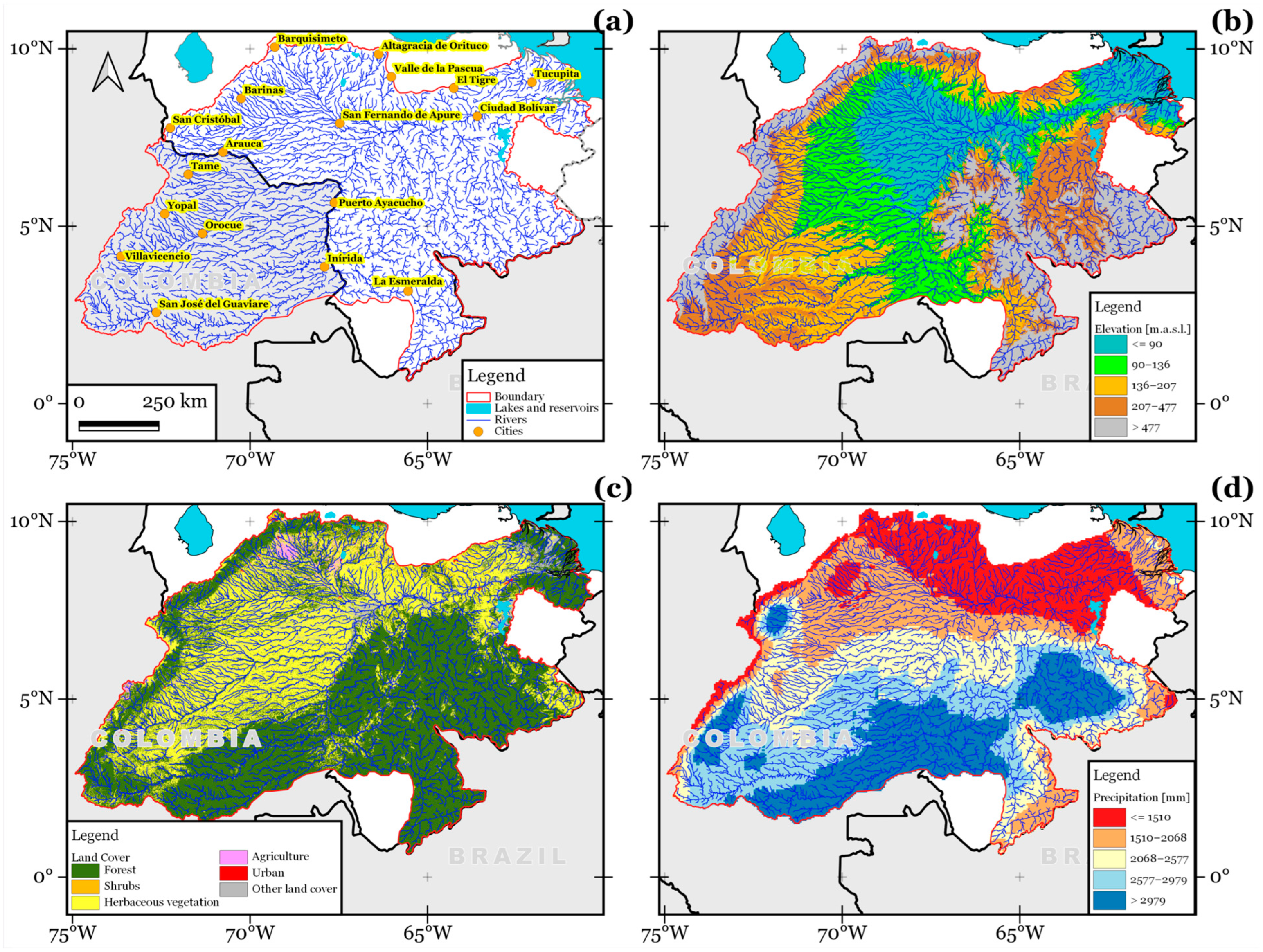
2.2. Observational Data and Data Based on Remote Sensing and Reanalysis
2.3. Analysis of the Trends in the Intensity and Area Affected by Dry Conditions
2.4. Analysis of the Relationship between the Spatial Extent of Droughts, ENSO, and Atlantic SST
2.5. Analysis of the Recurrence and Environmental Effects of Extreme Drought Events
2.6. Analysis of the Effect of Droughts on River Runoff
3. Results
3.1. Temporal Evolution of the Intensity of Droughts and the Area Affected by Dry Conditions
3.2. Relationship between the Spatial Extent of Droughts, ENSO, and SST in the Atlantic
3.3. Recurrence and Environmental Effects of Extreme Drought Events
3.4. Modulation of the Hydrological Regime by Droughts and Possible Implications on the Ichthyofauna
4. Discussion
5. Conclusions
- i.
- El Niño events worsen the region’s drought conditions, while Atlantic SST variability has less influence.
- ii.
- Long-term surface warming trends increase the evapotranspiration demand, aggravating drought conditions. However, vegetation greenness remains high despite high surface temperatures, suggesting that temperature alone does not significantly affect vegetation phenology and root zone water reserves. A sustained rainfall deficit is necessary to cause observable changes in the vegetation and soil conditions.
- iii.
- Droughts severely impact the infiltration–percolation process, affecting the long-term recharge rate of aquifers and their ecological flow contributions.
Author Contributions
Funding
Data Availability Statement
Acknowledgments
Conflicts of Interest
Appendix A
| BasinSPI | BasinDryAreaPct | NATL | SATL | Niño 3.4 | |
|---|---|---|---|---|---|
| BasinSPI | 1.000 | −0.857 | 0.117 | −0.045 | −0.221 |
| BasinDryAreaPct | −0.857 | 1.000 | −0.082 | 0.047 | 0.187 |
| NATL | 0.117 | −0.082 | 1.000 | 0.215 | 0.042 |
| SATL | −0.045 | 0.047 | 0.215 | 1.000 | −0.135 |
| Niño 3.4 | −0.221 | 0.187 | 0.042 | −0.135 | 1.000 |
| BasinDryAreaPct | k | |
|---|---|---|
| NATL | −0.146 | −6 |
| SATL | −0.118 | −7 |
| Niño 3.4 | 0.194 | −2 |
References
- Blauhut, V. The triple complexity of drought risk analysis and its visualization via mapping: A review across scales and sectors. Earth-Sci. Rev. 2020, 210, 103345. [Google Scholar] [CrossRef]
- Haile, G.; Tang, Q.; Sun, S.; Huang, Z.; Zhang, X.; Liu, X. Droughts in East Africa: Causes, impacts and resilience. Earth-Sci. Rev. 2019, 193, 146–161. [Google Scholar] [CrossRef]
- Olivares, B.O.; Zingaretti, M.L. Application of multivariate methods for the characterization of periods of meteorological drought in Venezuela. Rev. Luna Azul 2019, 48, 172–192. [Google Scholar] [CrossRef]
- Balocchi, F.; Rivera, D.; Arumi, J.L.; Morgenstern, U.; White, D.A.; Silberstein, R.P.; Ramírez de Arellano, P. An Analysis of the Effects of Large Wildfires on the Hydrology of Three Small Catchments in Central Chile Using Tritium-Based Measurements and Hydrological Metrics. Hydrology 2022, 9, 45. [Google Scholar] [CrossRef]
- Loaiza Cerón, W.; Carvajal-Escobar, Y.; Andreoli de Souza, R.V.; Toshie Kayano, M.; González López, N. Spatio-temporal analysis of the droughts in Cali, Colombia and their primary relationships with the El Niño-Southern Oscillation (ENSO) between 1971 and 2011. Atmosfera 2020, 33, 51–69. [Google Scholar] [CrossRef]
- Kreibich, H.; Van Loon, A.F.; Schröter, K.; Ward, P.J.; Mazzoleni, M.; Sairam, N.; Di Baldassarre, G. The challenge of unprecedented floods and droughts in risk management. Nature 2022, 608, 80–86. [Google Scholar] [CrossRef]
- Cavus, Y.; Aksoy, H. Critical drought severity/intensity-duration-frequency curves based on precipitation deficit. J. Hydrol. 2020, 584, 124312. [Google Scholar] [CrossRef]
- Paredes-Trejo, F.; Barbosa, H.A.; Giovannettone, J.; Lakshmi Kumar, T.V.; Thakur, M.K.; de Oliveira Buriti, C. Long-Term Spatiotemporal Variation of Droughts in the Amazon River Basin. Water 2021, 13, 351. [Google Scholar] [CrossRef]
- Cortez, A.; Orlando Olivares, B.; Mayela Parra, R.; Lobo, D.; Rey, B.J.C.; Rodriguez, M.F. Systematization of the calculation of the standardized precipitation index as a methodology to generate meteorological drought information. Rev. Fac. Agron. 2019, 36, 209–223. [Google Scholar]
- Barbosa, H.A.; Kumar, T.L.; Paredes, F.; Elliott, S.; Ayuga, J.G. Assessment of Caatinga response to drought using Meteosat-SEVIRI normalized difference vegetation index (2008–2016). ISPRS J. Photogramm. Remote Sens. 2019, 148, 235–252. [Google Scholar] [CrossRef]
- Hayes, M.; Svoboda, M.; Wall, N.; Widhalm, M. The Lincoln declaration on drought indices: Universal meteorological drought index recommended. Bull. Am. Meteorol. Soc. 2011, 92, 485–488. [Google Scholar] [CrossRef]
- Paredes-Trejo, F.; Olivares, B. El desafio de la sequía en Venezuela. In Atlas de Sequía de América Latina y el Caribe; Cobo, J.N., Verbist, K., Eds.; UNESCO: Paris, France, 2018; pp. 127–136. [Google Scholar]
- Olivares, B.; Cortez, A.; Parra, R.; Rodríguez, M.F.; Guevara, E. Application of statistics procedures for the quality control of the monthly rainfall series in the Venezuelan Oriental Plains. Rev. Fac. Agron. 2013, 30, 367–391. [Google Scholar]
- Golian, S.; Javadian, M.; Behrangi, A. On the use of satellite, gauge, and reanalysis precipitation products for drought studies. Environ. Res. Lett. 2019, 14, 075005. [Google Scholar] [CrossRef]
- Viloria, J.A.; Olivares, B.O.; García, P.; Paredes-Trejo, F.; Rosales, A. Mapping Projected Variations of Temperature and Precipitation Due to Climate Change in Venezuela. Hydrology 2023, 10, 96. [Google Scholar] [CrossRef]
- León, G. La cuenca del río Orinoco: Visión hidrográfica y balance hídrico. Rev. Geogr. Venez. 2005, 46, 75–108. [Google Scholar]
- Montoya, J.; Osío, A.; Pérez, M.; Pineda, V. Los ríos de los llanos de Apure. In Ríos en Riesgo de Venezuela; Rodríguez-Olarte, D., Ed.; Colección Recursos Hidrobiológicos de Venezuela; Universidad Centroccidental Lisandro Alvarado (UCLA): Barquisimeto, Venezuela, 2017; Volume 1, pp. 75–107. [Google Scholar]
- Rodríguez-Olarte, D.; Barrios, M.; Marrero, C.; Marcó, L. Río Turbio: Un síndrome urbano en la vertiente andina del Orinoco. Capítulo 3. In Ríos en Riesgo de Venezuela; Rodríguez-Olarte, D., Ed.; Colección Recursos Hidrobiológicos de Venezuela; Universidad Centroccidental Lisandro Alvarado (UCLA): Barquisimeto, Venezuela, 2017; Volume 1, pp. 59–74. [Google Scholar]
- Bedoya-Soto, J.; Poveda, G.; Trenberth, K.; Vélez-Upegui, J. Interannual hydroclimatic variability and the 2009–2011 extreme ENSO phases in Colombia: From Andean glaciers to Caribbean lowlands. Theor. Appl. Climatol. 2019, 135, 1531–1544. [Google Scholar] [CrossRef]
- Mendoza, N.; Puche, M. Evaluación de la ocurrencia de sequía en localidades de Venezuela. Rev. Fac. Agron. 2007, 24, 661–678. [Google Scholar]
- Olivares, B.; Cortez, A.; Lobo, D.; Parra, R.; Rey, B.; Juan, C.; Rodríguez, M. Estudio de la Sequía Meteorológica en Localidades de los Llanos de Venezuela Mediante el Índice de Precipitación Estandarizado. Acta Nova 2016, 7, 266–283. [Google Scholar]
- Olivares, B.; Zingaretti, M.L. Analysis of the meteorological drought in four agricultural locations of Venezuela by the combination of multivariate methods. UNED Res. J. 2018, 10, 181–192. [Google Scholar] [CrossRef]
- Beck, H.; Zimmermann, N.; McVicar, T.; Vergopolan, N.; Berg, A.; Wood, E. Present and future Köppen-Geiger climate classification maps at 1-km resolution. Sci. Data 2018, 5, 180214. [Google Scholar] [CrossRef]
- Builes-Jaramillo, A.; Yepes, J.; Salas, H.D. The Orinoco low-level jet during El Niño–Southern Oscillation. Int. J. Climatol. 2022, 42, 7863–7877. [Google Scholar] [CrossRef]
- Rodríguez-Yzquierdo, G.; Olivares, B.O.; Silva-Escobar, O.; González-Ulloa, A.; Soto-Suarez, M.; Betancourt-Vásquez, M. Mapping of the Susceptibility of Colombian Musaceae Lands to a Deadly Disease: Fusarium oxysporum f. sp. cubense Tropical Race 4. Horticulturae . Horticulturae 2023, 9, 757. [Google Scholar] [CrossRef]
- Torres Rojas, L.P.; Díaz-Granados, M. The Construction and Comparison of Regional Drought Severity-Duration-Frequency Curves in Two Colombian River Basins—Study of the Sumapaz and Lebrija Basins. Water 2018, 10, 1453. [Google Scholar] [CrossRef]
- Doxsey-Whitfield, E.; MacManus, K.; Adamo, S.; Pistolesi, L.; Squires, J.; Borkovska, O.; Baptista, S. Taking advantage of the improved availability of census data: A first look at the gridded population of the world, version 4. Pap. Appl. Geogr. 2015, 1, 226–234. [Google Scholar] [CrossRef]
- Buchhorn, M.; Lesiv, M.; Tsendbazar, N.-E.; Herold, M.; Bertels, L.; Smets, B. Copernicus Global Land Cover Layers—Collection 2. Remote Sens. 2020, 12, 1044. [Google Scholar] [CrossRef]
- Lehner, B.; Verdin, K.; Jarvis, A. HydroSHEDS Technical Documentation, Version 1.0; World Wildlife Fund: Washington, DC, USA, 2006; pp. 1–27. [Google Scholar]
- Jarvis, A.; Reuter, H.; Nelson, A.; Guevara, E. 2008. Hole-Filled SRTM for the Globe Version 4. Available from the CGIAR-CSI SRTM 90m Database. Volume 15, pp. 25–54. Available online: http://srtm.csi.cgiar.org (accessed on 11 May 2023).
- Funk, C.; Peterson, P.; Landsfeld, M.; Pedreros, D.; Verdin, J.; Shukla, S.; Michaelsen, J. The climate hazards infrared precipitation with stations—A new environmental record for monitoring extremes. Sci. Data 2015, 2, 150066. [Google Scholar] [CrossRef]
- McKee, T.B.; Doesken, N.J.; Kleist, J. The relationship of drought frequency and duration to time scales. In Proceedings of the 8th Conference on Applied Climatology, Anaheim, CA, USA, 17–22 January 1993; American Meteorological Society: Boston, MA, USA, 1993; Volume 17, Nº. 22. pp. 179–183. [Google Scholar]
- Trejo, F.; Barbosa, H.; Peñaloza-Murillo, M.; Moreno, M.; Farías, A. Intercomparison of improved satellite rainfall estimation with CHIRPS gridded product and rain gauge data over Venezuela. Atmósfera 2016, 29, 323–342. [Google Scholar]
- Urrea, V.; Ochoa, A.; Mesa, O. Seasonality of Rainfall in Colombia. Water Resour. Res. 2019, 55, 4149–4162. [Google Scholar] [CrossRef]
- Hersbach, H.; Bell, B.; Berrisford, P.; Hirahara, S.; Horányi, A.; Muñoz-Sabater, J.; Thépaut, J. The ERA5 global reanalysis. Q. J. R. Meteorol. 2020, 146, 1999–2049. [Google Scholar] [CrossRef]
- Tarek, M.; Brissette, F.; Arsenault, R. Evaluation of the ERA5 reanalysis as a potential reference dataset for hydrological modelling over North America. Hydrol. Earth Syst. Sci. 2020, 24, 2527–2544. [Google Scholar] [CrossRef]
- Didan, K.; Muñoz, A.B.; Solano, R.; Huete, A. MODIS Vegetation Index User’s Guide; MOD13 Series; University of Arizona, Vegetation Index and Phenology Lab: Tucson, AZ, USA, 2015; pp. 2–33. [Google Scholar]
- Huete, A.; Didan, K.; Miura, T.; Rodríguez, E.; Gao, X.; Ferreira, L. Overview of the radiometric and biophysical performance of the MODIS vegetation indices. Remote Sens. Environ. 2002, 83, 195–213. [Google Scholar] [CrossRef]
- Baek, S.; Jang, H.; Kim, J.; Lee, J. Agricultural drought monitoring using the satellite-based vegetation index. J. Korea Water Resour. Assoc. 2016, 49, 305–314. [Google Scholar] [CrossRef]
- Huang, B.; Thorne, P.; Banzon, V.; Boyer, T.; Chepurin, G.; Lawrimore, J.; Zhang, H. Extended reconstructed sea surface temperature, version 5 (ERSSTv5): Upgrades, validations, and intercomparisons. J. Clim. 2017, 30, 8179–8205. [Google Scholar] [CrossRef]
- Poveda, G.; Jaramillo, A.; Gil, M.; Quiceno, N.; Mantilla, R. Seasonally in ENSO-related precipitation, river discharges, soil moisture, and vegetation index in Colombia. Water Resour. Res. 2001, 37, 2169–2178. [Google Scholar] [CrossRef]
- Glenn, E.; Comarazamy, D.; González, J.; Smith, T. Detection of recent regional sea surface temperature warming in the Caribbean and surrounding region. Geophys. Res. Lett. 2015, 42, 6785–6792. [Google Scholar] [CrossRef]
- Yue, S.; Wang, C. Applicability of prewhitening to eliminate the influence of serial correlation on the Mann-Kendall test. Water Resour. Res. 2002, 38, 4-1. [Google Scholar] [CrossRef]
- Mudelsee, M. Climate time series analysis. In Classical Statistical and Bootstrap Methods, 2nd ed.; Springer: Cham, Switzerland, 2014; 454p. [Google Scholar] [CrossRef]
- Tim, N.; De Guenni, L. Oceanic influence on the precipitation in Venezuela under current and future climate. Clim. Dyn. 2016, 47, 211–234. [Google Scholar] [CrossRef]
- Arias, P.A.; Garreaud, R.; Poveda, G.; Espinoza, J.C.; Molina-Carpio, J.; Masiokas, M.; Viale, M.; Scaff, L.; Van Oevelen, P.J. Hydroclimate of the Andes part II: Hydroclimate variability and sub-continental patterns. Front. Earth Sci. 2021, 8, 666. [Google Scholar] [CrossRef]
- López-Beltrán, M.; Olivares, B.; Lobo-Luján, D. Changes in land use and vegetation in the agrarian community Kashaama, Anzoátegui, Venezuela: 2001–2013. Rev. Geogr. Am. Cent. 2019, 2, 269–291. [Google Scholar] [CrossRef]
- Olivares, B.; López, M. Normalized Difference Vegetation Index (NDVI) applied to the agricultural indigenous territory of Kashaama, Venezuela. UNED Res. J. 2019, 11, 112–121. [Google Scholar] [CrossRef]
- Van Loon, A.F. Hydrological drought explained. Wiley Interdiscip. Rev. Water 2015, 2, 359–392. [Google Scholar] [CrossRef]
- Van Loon, A.F.; Laaha, G.J. Hydrological drought severity explained by climate and catchment characteristics. J. Hydrol. 2015, 526, 3–14. [Google Scholar] [CrossRef]
- Rojas, M.; Alfaro, E. Influencia del océano Atlántico tropical sobre el comportamiento de la primera parte de la estación lluviosa en Venezuela. Top. Meteor. Oceanogr. 2000, 7, 88–92. [Google Scholar]
- Poveda, G.; Waylen, P.; Pulwarty, R. Annual and inter-annual variability of the present climate in northern South America and southern Mesoamerica. Palaeogeogr. Palaeoclimatol. Palaeoecol. 2006, 234, 3–27. [Google Scholar] [CrossRef]
- Correa, I.; Segnini, S.; Chacón, M.; Bianchi, G.; Casado, R.; Romero, R. Condición ecológica en ríos de los páramos andinos de Venezuela. In Ríos en Riesgo de Venezuela; Rodríguez-Olarte, D., Ed.; Recursos Hidrobiológicos de Venezuela; Universidad Centroccidental Lisandro Alvarado (UCLA): Barquisimeto, Venezuela, 2020; Volume 3, pp. 111–134. [Google Scholar]
- Machado-Allison, A.; Chernoff, B. El río Caura: Desde la pristinidad a su destrucción. In Ríos en Riesgo de Venezuela; Rodríguez-Olarte, D., Ed.; Recursos Hidrobiológicos de Venezuela; Universidad Centroccidental Lisandro Alvarado (UCLA): Barquisimeto, Venezuela, 2020; Volume 3, pp. 39–56. [Google Scholar]
- Russell, A.M.; Gnanadesikan, A.; Zaitchik, B. Are the Central Andes mountains a warming hot spot? J. Clim. 2017, 30, 3589–3608. [Google Scholar] [CrossRef]
- Saavedra, F.; Kampf, S.; Fassnacht, S.; Sibold, J.S. Changes in Andes snow cover from MODIS data, 2000–2016. Cryosphere 2018, 12, 1027–1046. [Google Scholar] [CrossRef]
- Aguilar-Lome, J.; Espinoza-Villar, R.; Espinoza, J.; Rojas-Acuña, J.; Willems, B.; Leyva-Molina, W. Elevation-dependent warming of land surface temperatures in the Andes assessed using MODIS LST time series (2000–2017). Int. J. Appl. Earth Obs. Geoinf. 2019, 77, 119–128. [Google Scholar] [CrossRef]
- Olivares, B.; Parra, R.; Cortez, A. Characterization of precipitation patterns in Anzoátegui state, Venezuela. Ería 2017, 3, 353–365. [Google Scholar] [CrossRef][Green Version]
- Olivares, B.; Hernández, R. Regional analysis of homogeneous precipitation areas in Carabobo, Venezuela. Rev. Lasallista Investig. 2019, 16, 90–105. [Google Scholar] [CrossRef]
- Pahl-Wostl, C. Transitions towards adaptive management of water facing climate and global change. Water Resour. Impact 2007, 21, 49–62. [Google Scholar] [CrossRef]
- Trejo, F.; Barbosa, H.; Ruiz, I.; Peñaloza-Murillo, M. Meso-scale oceanic atmospheric circulation patterns linked with severe and extensive droughts in Venezuela. Rev. Bras. Meteorol. 2016, 31, 468–489. [Google Scholar] [CrossRef][Green Version]
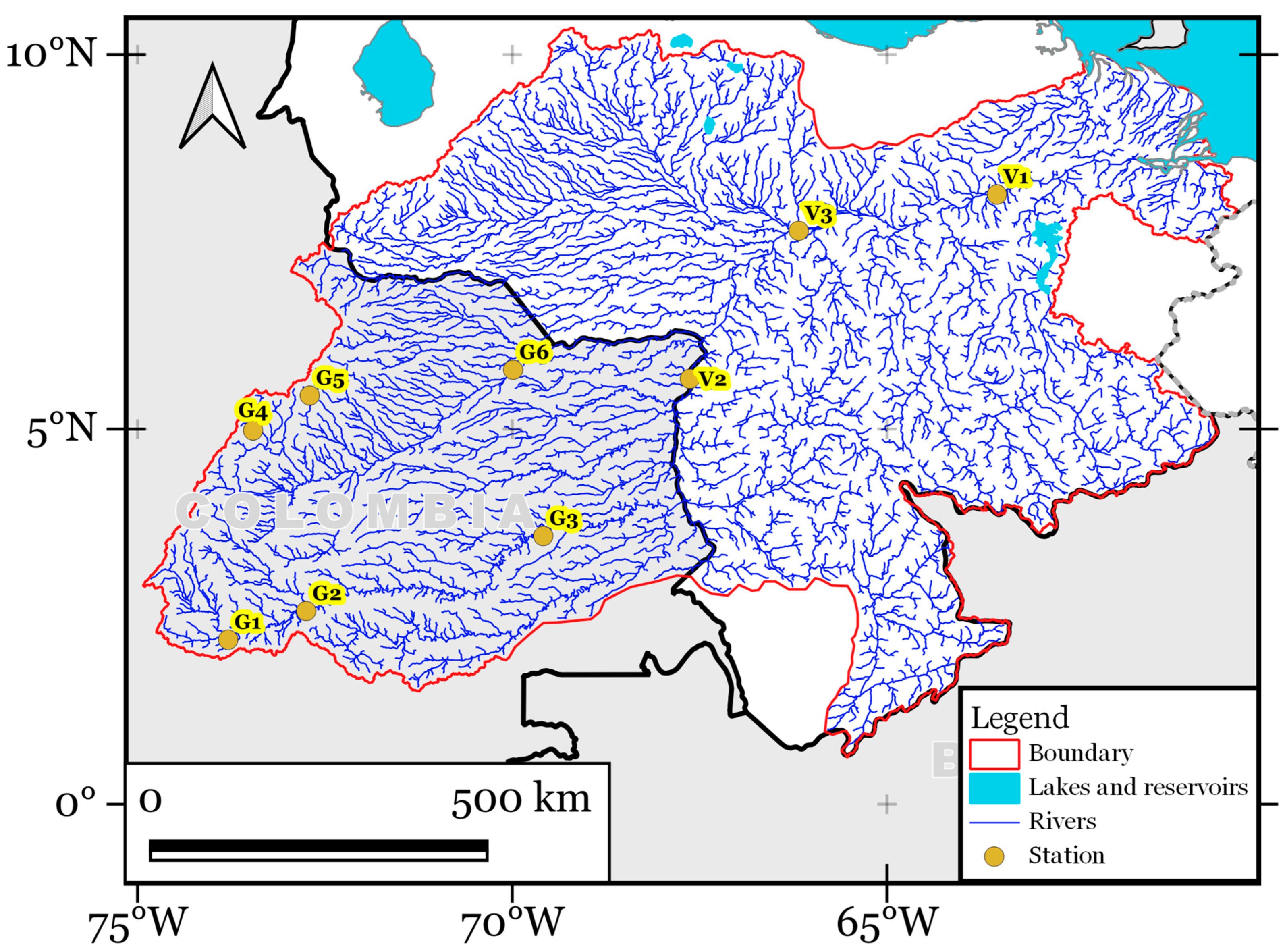
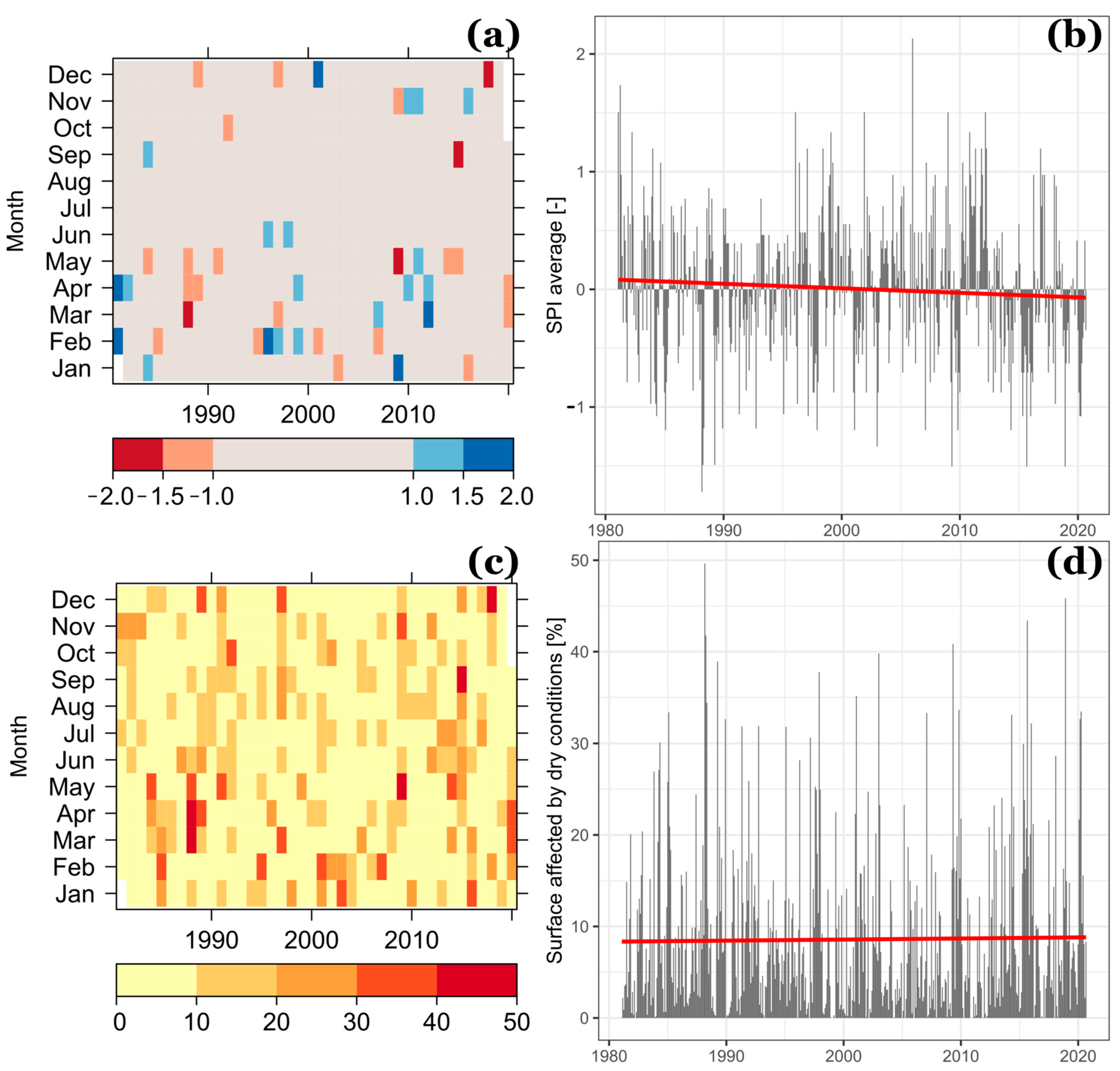
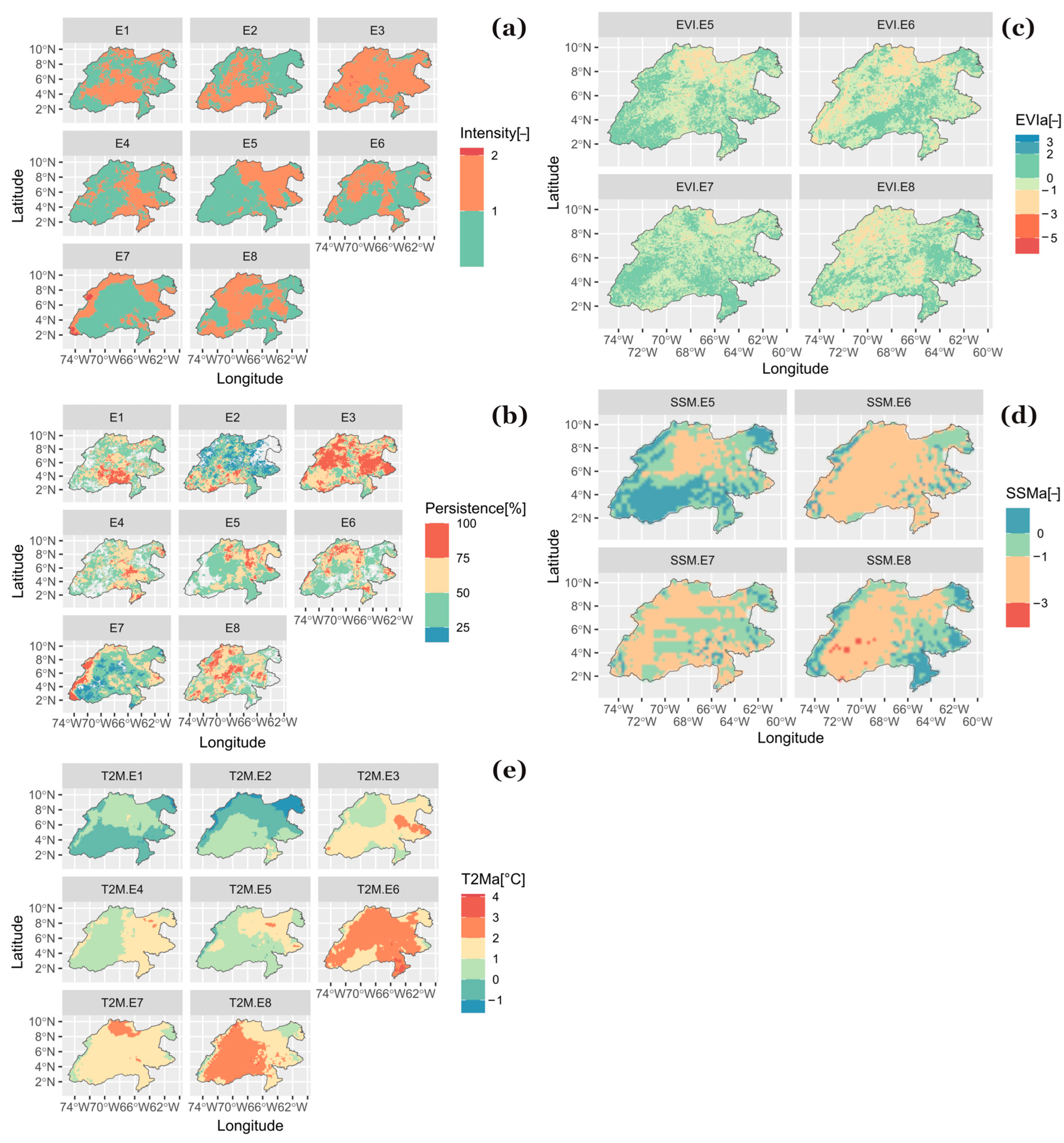
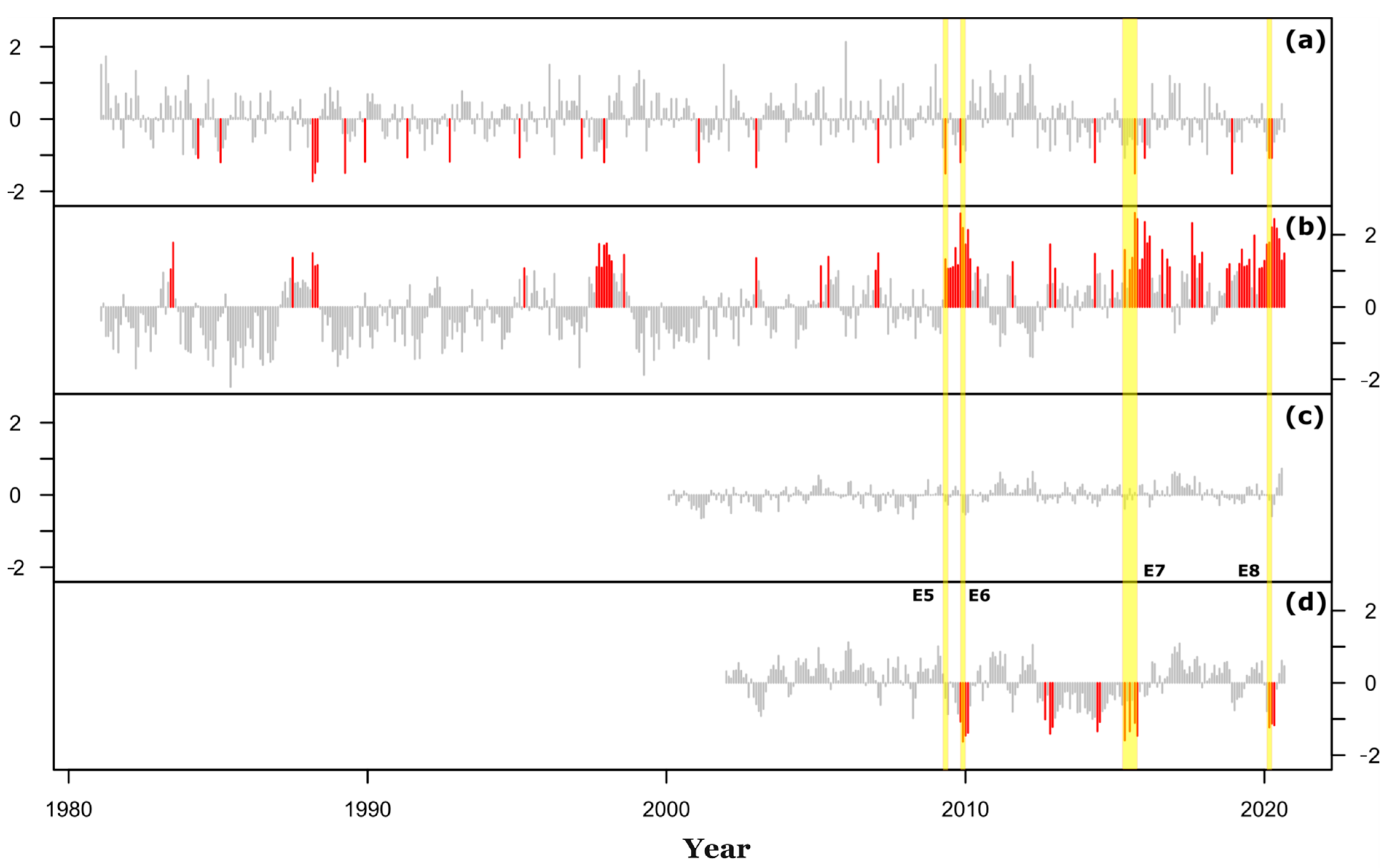
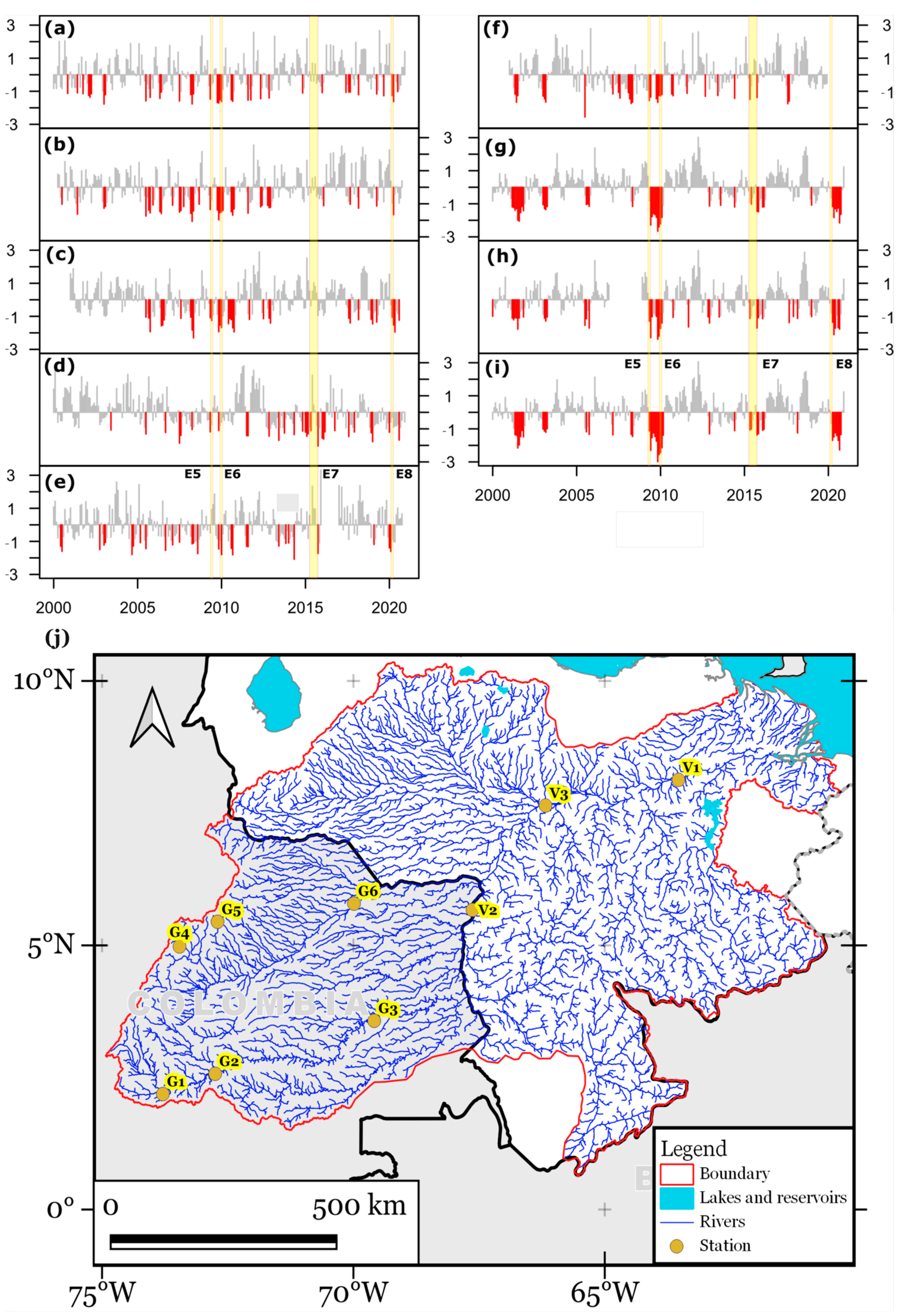
| Events | Starting (Month/Year) | Ending (Month/Year) | Duration (n) | Max. Coverage (%) | Severity (−) | Average Intensity (−) |
|---|---|---|---|---|---|---|
| E1 | Mar. 84 | May. 84 | 3 | 30.07 | 4.99 | 1.66 |
| E2 | Jan. 85 | Abril 85 | 4 | 33.36 | 6.52 | 1.63 |
| E3 | Mar. 88 | May. 88 | 3 | 49.65 | 5.17 | 1.72 |
| E4 | Aug. 97 | Oct. 97 | 3 | 25.28 | 4.99 | 1.66 |
| E5 | Apr. 09 | Jun. 09 | 3 | 40.85 | 4.99 | 1.66 |
| E6 | Nov. 09 | Jan. 10 | 3 | 33.64 | 4.84 | 1.61 |
| E7 | Apr. 15 | Oct. 15 | 7 | 43.42 | 11.74 | 1.68 |
| E8 | Feb. 20 | Apr. 20 | 3 | 33.45 | 4.84 | 1.61 |
| G1 | G2 | G3 | G4 | G5 | G6 | V1 | V2 | V3 | |
|---|---|---|---|---|---|---|---|---|---|
| G1 | |||||||||
| G2 | 0.867 ** | ||||||||
| G3 | 0.618 ** | 0.748 ** | |||||||
| G4 | 0.279 ** | 0.366 ** | 0.321 ** | ||||||
| G5 | 0.370 ** | 0.431 ** | 0.334 ** | 0.560 ** | |||||
| G6 | 0.471 ** | 0.571 ** | 0.556 ** | 0.460 ** | 0.493 ** | ||||
| V1 | 0.315 ** | 0.372 ** | 0.522 ** | 0.253 ** | 0.176 n.s. | 0.441 ** | |||
| V2 | 0.485 ** | 0.556 ** | 0.706 ** | 0.310 ** | 0.243 ** | 0.536 ** | 0.903 ** | ||
| V3 | 0.386 ** | 0.482 ** | 0.616 ** | 0.279 ** | 0.229 ** | 0.535 ** | 0.970 ** | 0.921 ** |
Disclaimer/Publisher’s Note: The statements, opinions and data contained in all publications are solely those of the individual author(s) and contributor(s) and not of MDPI and/or the editor(s). MDPI and/or the editor(s) disclaim responsibility for any injury to people or property resulting from any ideas, methods, instructions or products referred to in the content. |
© 2023 by the authors. Licensee MDPI, Basel, Switzerland. This article is an open access article distributed under the terms and conditions of the Creative Commons Attribution (CC BY) license (https://creativecommons.org/licenses/by/4.0/).
Share and Cite
Paredes-Trejo, F.; Olivares, B.O.; Movil-Fuentes, Y.; Arevalo-Groening, J.; Gil, A. Assessing the Spatiotemporal Patterns and Impacts of Droughts in the Orinoco River Basin Using Earth Observations Data and Surface Observations. Hydrology 2023, 10, 195. https://doi.org/10.3390/hydrology10100195
Paredes-Trejo F, Olivares BO, Movil-Fuentes Y, Arevalo-Groening J, Gil A. Assessing the Spatiotemporal Patterns and Impacts of Droughts in the Orinoco River Basin Using Earth Observations Data and Surface Observations. Hydrology. 2023; 10(10):195. https://doi.org/10.3390/hydrology10100195
Chicago/Turabian StyleParedes-Trejo, Franklin, Barlin O. Olivares, Yair Movil-Fuentes, Juan Arevalo-Groening, and Alfredo Gil. 2023. "Assessing the Spatiotemporal Patterns and Impacts of Droughts in the Orinoco River Basin Using Earth Observations Data and Surface Observations" Hydrology 10, no. 10: 195. https://doi.org/10.3390/hydrology10100195
APA StyleParedes-Trejo, F., Olivares, B. O., Movil-Fuentes, Y., Arevalo-Groening, J., & Gil, A. (2023). Assessing the Spatiotemporal Patterns and Impacts of Droughts in the Orinoco River Basin Using Earth Observations Data and Surface Observations. Hydrology, 10(10), 195. https://doi.org/10.3390/hydrology10100195








